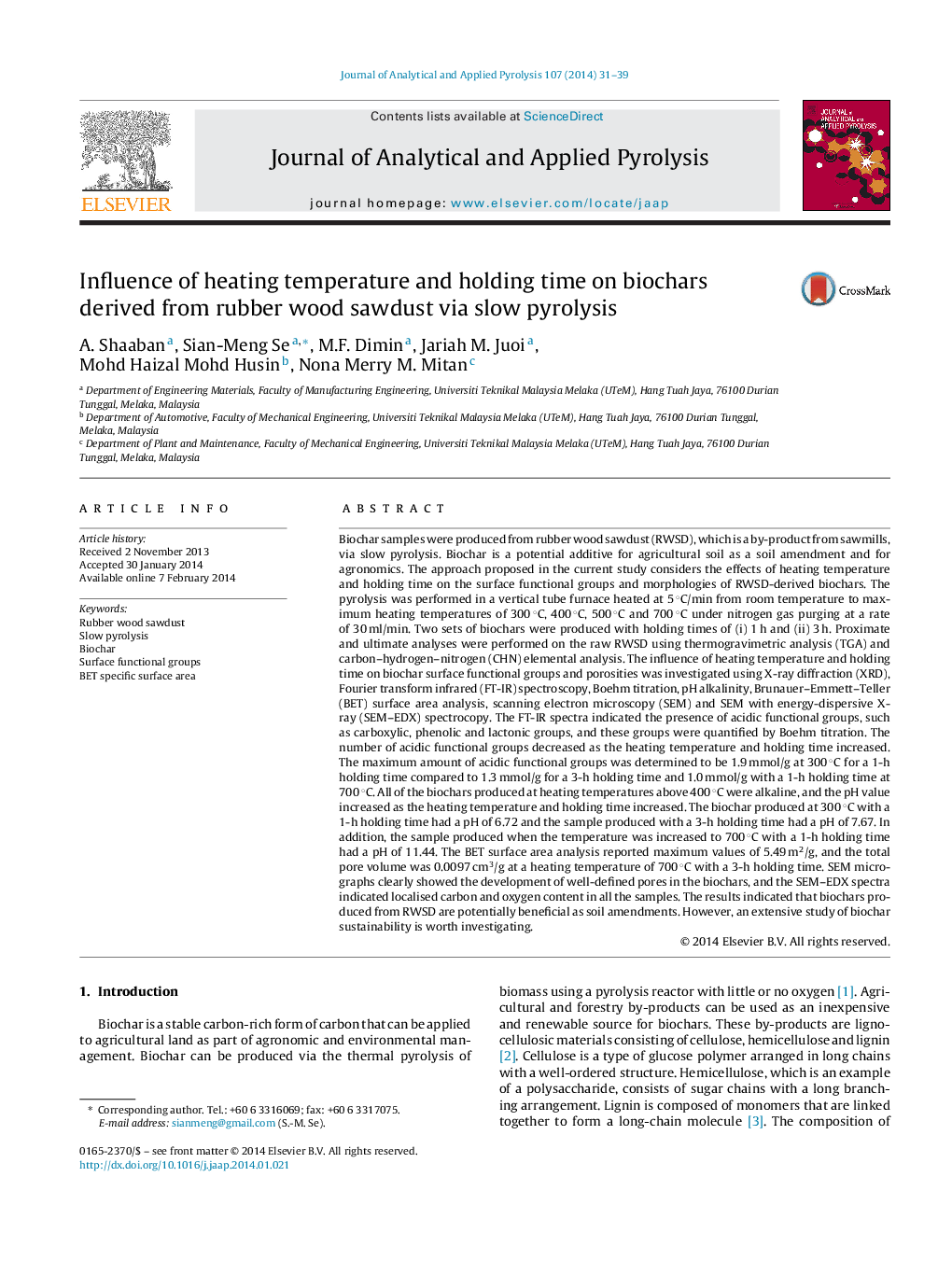| کد مقاله | کد نشریه | سال انتشار | مقاله انگلیسی | نسخه تمام متن |
|---|---|---|---|---|
| 1198283 | 1492970 | 2014 | 9 صفحه PDF | دانلود رایگان |
• Biochars were derived from rubber wood sawdust via slow pyrolysis.
• Heating temperatures (HT) ranged from 300 to 700 °C and retention time (RT) ranged from 1 to 3 h.
• They were characterised by XRD, FT-IR, Boehm titration, pH, BET, SEM and SEM–EDX.
• At low HT and RT, biochar consists of more acidic groups with lower pH.
• At high HT and RT, biochar obtained larger surface area and total pore volume.
Biochar samples were produced from rubber wood sawdust (RWSD), which is a by-product from sawmills, via slow pyrolysis. Biochar is a potential additive for agricultural soil as a soil amendment and for agronomics. The approach proposed in the current study considers the effects of heating temperature and holding time on the surface functional groups and morphologies of RWSD-derived biochars. The pyrolysis was performed in a vertical tube furnace heated at 5 °C/min from room temperature to maximum heating temperatures of 300 °C, 400 °C, 500 °C and 700 °C under nitrogen gas purging at a rate of 30 ml/min. Two sets of biochars were produced with holding times of (i) 1 h and (ii) 3 h. Proximate and ultimate analyses were performed on the raw RWSD using thermogravimetric analysis (TGA) and carbon–hydrogen–nitrogen (CHN) elemental analysis. The influence of heating temperature and holding time on biochar surface functional groups and porosities was investigated using X-ray diffraction (XRD), Fourier transform infrared (FT-IR) spectroscopy, Boehm titration, pH alkalinity, Brunauer–Emmett–Teller (BET) surface area analysis, scanning electron microscopy (SEM) and SEM with energy-dispersive X-ray (SEM–EDX) spectrocopy. The FT-IR spectra indicated the presence of acidic functional groups, such as carboxylic, phenolic and lactonic groups, and these groups were quantified by Boehm titration. The number of acidic functional groups decreased as the heating temperature and holding time increased. The maximum amount of acidic functional groups was determined to be 1.9 mmol/g at 300 °C for a 1-h holding time compared to 1.3 mmol/g for a 3-h holding time and 1.0 mmol/g with a 1-h holding time at 700 °C. All of the biochars produced at heating temperatures above 400 °C were alkaline, and the pH value increased as the heating temperature and holding time increased. The biochar produced at 300 °C with a 1-h holding time had a pH of 6.72 and the sample produced with a 3-h holding time had a pH of 7.67. In addition, the sample produced when the temperature was increased to 700 °C with a 1-h holding time had a pH of 11.44. The BET surface area analysis reported maximum values of 5.49 m2/g, and the total pore volume was 0.0097 cm3/g at a heating temperature of 700 °C with a 3-h holding time. SEM micrographs clearly showed the development of well-defined pores in the biochars, and the SEM–EDX spectra indicated localised carbon and oxygen content in all the samples. The results indicated that biochars produced from RWSD are potentially beneficial as soil amendments. However, an extensive study of biochar sustainability is worth investigating.
Journal: Journal of Analytical and Applied Pyrolysis - Volume 107, May 2014, Pages 31–39
